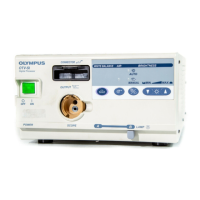50
Chapter 5 Operation
VIDEO SYSTEM OTV-SI
Chapter 5 Operation
The operator of this instrument must be a physician or medical personnel under
the supervision of a physician and must have received sufficient training in
clinical endoscopic technique. This manual, therefore, does not explain or
discuss clinical endoscopic procedures. It only describes basic operation and
precautions related to the operation of this instrument.
• Should any irregularity be suspected in the instrument’s
performance (e.g., unidentifiable noises, smells, etc.), or if
fluid enters the unit, immediately stop using the instrument.
• Anytime you suspect an abnormality in a video system
function, stop using the equipment immediately and take
action according to the following procedures. Using a
defective video system may cause damage to the patient’s
health. In addition, be sure to prepare another video system
to avoid that the examination must be interrupted due to
instrument failure or malfunction.
If the endoscopic image disappears or the image freezes
and cannot be restored :
Turn the OTV-SI OFF. Then turn it back ON again. For
ancillary equipment used in conjunction with the OTV-SI,
also turn the power OFF and then ON again as directed in
their respective instruction manuals. If this fails to correct
the problem, immediately stop using the equipment and
slowly remove the endoscope from the patient as
described in the camera head’s or endoscope’s
instruction manual.
If any other abnormality occurs or is suspected :
Immediately stop using the equipment and gently remove
the endoscope from the patient as described in the
camera head’s or endoscope’s instruction manual.
• Wear personal protective equipment to guard against
dangerous chemicals and potentially infectious material.
During operation, wear appropriate personal protective
equipment, such as eye wear, a face mask,
moisture-resistant clothing and chemical-resistant gloves that
fit properly and are long enough so that your skin is not
exposed.

